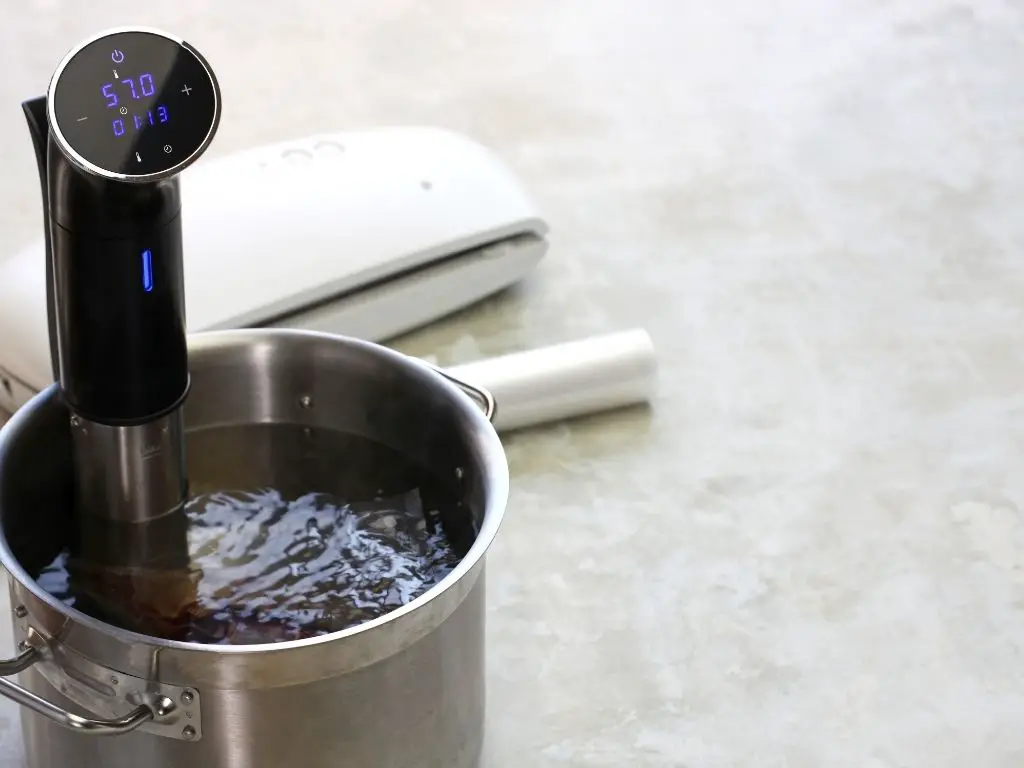Sous vide cooking involves cooking food sealed in airtight bags immersed in temperature controlled water. Determining the right amount of water to use for sous vide cooking is important for ensuring proper temperature regulation and circulation. Here’s what you need to know:

Sous Vide Products I Use Every Day
As an Amazon affiliate, I earn from qualifying purchases.
Last update on 2025-03-03 / Affiliate links / Images from Amazon Product Advertising API
Water Level and Container Size
The general rule of thumb is that you need enough water to fully cover whatever food you are cooking. Most experts recommend having at least 2-3 inches of water above the food.
The size of your sous vide water bath container also factors into the water level. For large sous vide cookers or coolers, you may need 6 or more inches of water to properly circulate heat. For smaller sous vide cookers, just covering the food by 2-3 inches is sufficient.
A good tip is to fill your sous vide container about two-thirds to three-quarters full with water.
This allows ample room for water circulation while still keeping the volume of water needed lower.
Water Displacement Method
An easy way to determine how much water you need is using the water displacement method.
Follow these steps:
- Place your vacuum sealed sous vide bags into the container.
- Fill with water until the bags are fully submerged by 2-3 inches.
- Mark the water line.
- Remove bags and fill to the water line.
The water displaced by the bags shows the minimum needed to properly cook.
Ensuring Proper Water Circulation
Proper water circulation is crucial for even cooking. Here are some tips:
- Use a container with a lid to minimize evaporation.
- Use a sous vide circulator or pump to keep the water moving.
- Avoid overpacking the container which can impede circulation.
- Use a rack or weights to keep bags fully submerged.
- Stir the water occasionally to prevent hot/cold spots.
Tips for Sous Vide Cooking Success
Follow these tips to get the most out of your sous vide cooking:
Use a Sous Vide Container with a Lid or Cover
Covering your sous vide container helps minimize evaporative heat loss. Lids help maintain precise temperature control.
Preheat the Water Before Adding Food
Heating the water to the target temperature before adding your sealed food ensures the water bath temp doesn’t drop when food is added.
Use a Sous Vide Rack to Keep Food Submerged
Special sous vide racks or wire trivets keep food bags weighed down and prevent them from floating during cooking.
Monitor the Water Level Throughout the Cooking Process
Check the water periodically to ensure the minimum level is maintained as steam evaporates. Top off with hot water as needed.
Adjust Cooking Time for Different Food Thicknesses
Thicker cuts of meat or dense vegetables may require slightly longer cooking than thinner, smaller pieces.
Finish Your Dish with a Sear or Other Finishing Technique
Searing, broiling, or grilling after sous vide lends color, texture, and flavor.
Conclusion: Enjoying Perfectly Cooked Sous Vide Dishes
Following these tips will help you achieve sous vide success with deliciously cooked meats, vegetables, eggs, and more every time. Precision temperature control paired with proper water circulation results in food that is cooked to tender, juicy perfection. Take your cooking to the next level with sous vide!


![IMPRESA [10 Pack] Sous Vide Magnet Weights for Keeping Bags Submerged – Sous Vide Accessories to Stop Floating Bags & Undercooking – Weighted Magnets for Containers](https://m.media-amazon.com/images/I/41zHpl8G2lL._SL160_.jpg)

